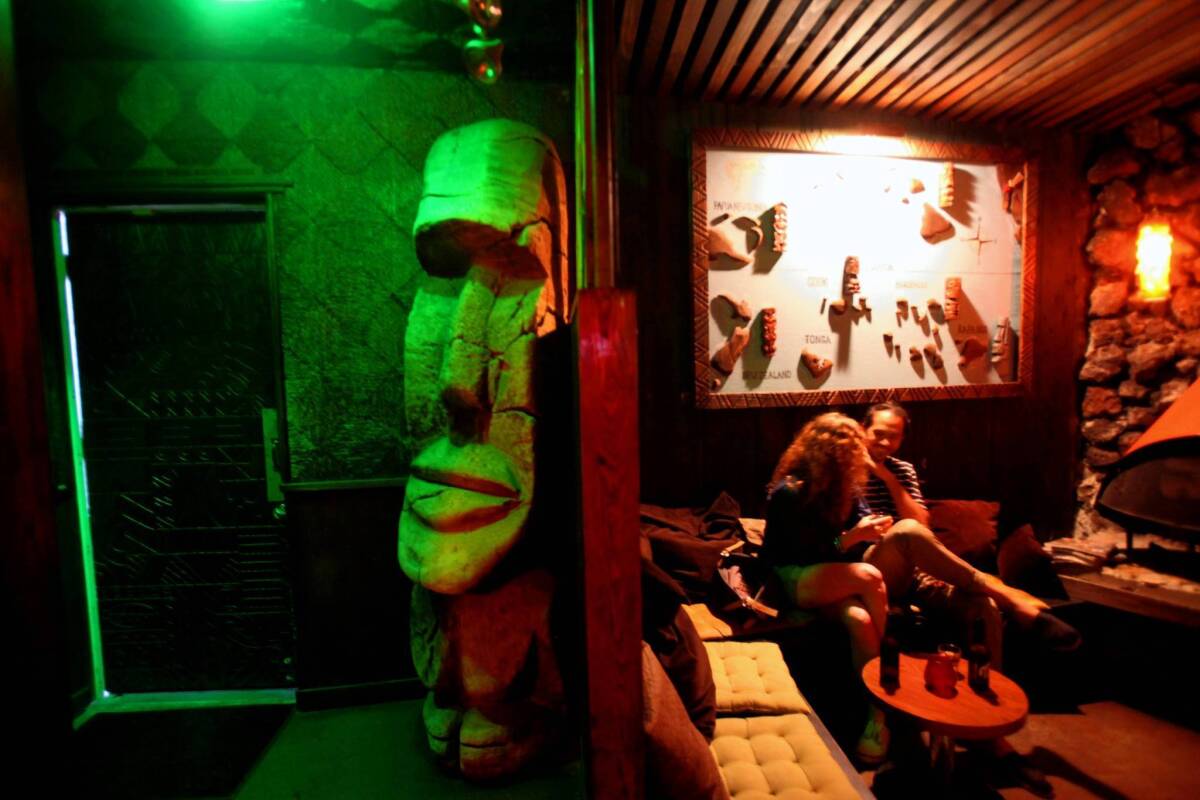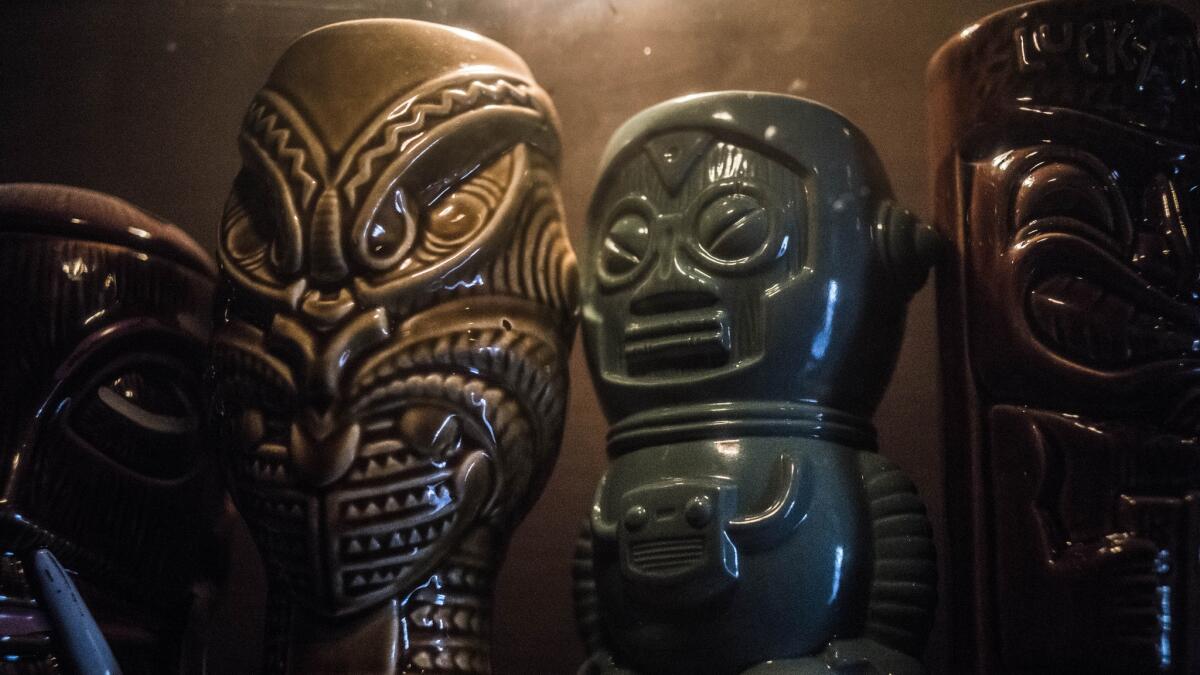Tiki bars are built on cultural appropriation and colonial nostalgia. Where’s the reckoning?
The orgy looks like it’ll start any minute in that grove of coconut palms beyond the luau table, a heap of suckling piglets and pineapples, roast chickens and splayed banana clusters all piled against an enormous, open barrel of rum. Brown, half-nude men draped with leis clutch island women with flowers in their hair. They form an undulating circle of sexualized bodies, their faces cartoony and grotesque, a collection of rubbery lips, eyes drawn as slits and frying-pan noses: a racist fantasy of happy natives with stoked libidos, down to rut.
The illustration is by French artist Guy Huzé. It’s in “Trader Vic’s Book of Food and Drink” by Victor Bergeron (published by Doubleday in 1946), a founding pillar of the cocktail, design and culture known today as tiki (though not in ’46). It’s the book that gave the world the mai tai, Bergeron’s legacy, a drink of genius.
For the record:
10:06 a.m. Dec. 2, 2019An article cited by Martin Cate was misattributed to Cory Starr of Three Dots and a Dash. The article was written by C.W. Gross.
There’s so much about tiki I love, especially happy hour mai tais at Trader Vic’s in Emeryville, on the eastern flank of San Francisco Bay, with its barroom views out to a snug marina. Look almost anywhere else in that room, though (at the vintage drawings illustrating cocktails from Vic Bergeron’s early days, for example, when Vic’s was on a car-choked strip of north Oakland), and the scenery becomes more troubling, suggestive of those Huzé illustrations.
While the racist tenor of artifacts from America’s cultural past have come under scrutiny — team mascots, statues in the public square, restaurants wrapped in colonial nostalgia — tiki has avoided any serious reckoning over its imagery or the commandeering of objects and symbols from other cultures. It certainly hasn’t included voices of Pacific Islanders, whose gods have been rendered into cocktail mugs and medallions and ancient design motifs turned into kitschy fabric for muumuus and cabana sets.

Which is not to say that, as pure mixology, tiki hasn’t proven its brilliance. Martin Cate of Smuggler’s Cove in San Francisco, Jeff “Beachbum” Berry of Latitude 29 in New Orleans, as well as tiki’s founding fathers, Bergeron and Donn Beach: Their artistry and advocacy for Caribbean rums has been a powerful source of delight in a world seriously in need of it. Yet this sophisticated culture of drinks has been tethered to a crude imperialist fantasy that has treated the South Pacific as a source of escape.
“I do not appreciate colonial nostalgia,” says Stephanie Nohelani Teves, assistant professor in women’s studies at the University of Hawaii at Mānoa and author of “Defiant Indigeneity: The Politics of Hawaiian Performance.” She’s a Kanaka Maoli (a Hawaii native), born and raised on Oahu though her family roots extend to Maui. “Tiki bars are not cute.”
And that’s the problem with tiki: how to honor its real contributions to mixology while resisting the parts that dishonor indigenous people, misuse their iconography and exploit their sacred traditions. In a woke world, is there hope for tiki?
Polynesian colonialism
America’s presence in Polynesia is the result of military expansion: We seized Hawaii in the 1890s for its geo-strategic value (same with Samoa, carved up by Western colonial powers in 1899), and we exerted control over various islands during and after World War II.
Tiki’s roots stretch to the 1930s and two proudly divey California bars, both run by men with a talent for creating myths as potent as their drinks. Ernest Raymond Beaumont Gantt was a drifter who opened a tiny bar in 1933 in an old tailor’s shop in Hollywood. He called it Don’s Beachcomber (eventually Don the Beachcomber). It was, as Cate describes in his 2016 book “Smuggler’s Cove: Exotic Cocktails, Rum, and the Cult of Tiki,” a rough-edged, tropical fantasy bar, “one man’s vision of an island rum shack.” Gantt changed his name to Donn Beach.
Meanwhile in Oakland, Bergeron built a one-room bar he named Hinky Dinks. In 1937, inspired by a trip to Havana and Bar La Florida (also to Albert Martin’s Bon Ton Bar in New Orleans and Don the Beachcomber) Bergeron built a backroom addition, the Bamboo Room, “for ladies and their escorts,” the opening notice read, where the prime decorative flourish was a large staghorn fern. Bergeron took up the moniker Trader Vic, which gave him the aura of an island rum trafficker. His menu portrayed the Trader with a smirk and a bucket hat, flanked by topless native women.
By the early 1950s, when Bergeron launched his Trader Vic’s flagship in San Francisco, and Beach, along with his wife, Cora “Sunny” Sund, were presiding over Don the Beachcomber branches in Chicago and Palm Springs, all the elements of tiki’s golden era were in place.
The word “tiki” traces to New Zealand and the Marquesas Islands. It refers to sacred images of gods and creation. In the plasticized, popcorn-ceilinged suburbs of post-WWII America, “tiki” evoked a lost world of palm-ringed beaches, happy natives and rum-fueled sexual release: a world as drenched in color as the 1958 movie of Rodgers and Hammerstein’s “South Pacific.” With a plate of rumaki, goopy spare ribs and a Samoan Fog Cutter in a hula-girl mug (available at the restaurant gift shop), anyone could find their own Bali Ha’i. Places like the Luau in Beverly Hills, the Tonga Room in San Francisco and the Mai-Kai in Fort Lauderdale created sticky, pineapple-sweet microverses.
By the late 1960s, during its decline, a politically more progressive generation of Americans saw tiki as retrograde or worse.
“What once seemed charming and naive about island peoples and cultures,” Cate writes in “Smuggler’s Cove,” “now seemed, to a generation raised in a more globally aware world, to be at best patronizing or inauthentic, and at worst simply racist.”
The nostalgia people express through tiki is offensive because it forgets that this colonialism and militarism is ongoing, not temporary. Not past. Not over.
— Stephanie Nohelani Teves
Then, starting in 1990, tiki came back from the dead — with a Midcentury Modern bent. In the current revival — phase three — German filmmaker Sven Kirsten, who relocated to Los Angeles, became an archaeologist of golden-era tiki-ana. In 1994, he coined a term for the midcentury design ethos of vintage mugs, cabana suits and replica moai (the famous Rapa Nui monoliths of Easter Island): Polynesian Pop. Kirsten’s “The Book of Tiki,” published in 2000, is a manifesto for the revival of the genre.
Polynesian Pop seduced St. John Frizell, drinks writer, bartender and owner of Fort Defiance in Brooklyn, where he hosts a weekly tiki night called the Sunken Harbor Club.
“Tiki became associated strongly not with native South Sea Island culture, and not really with drinks either, but Midcentury Modern aesthetics,” he said of his introduction to tiki in the ’90s.
Frizell has attended the annual Hukilau in Fort Lauderdale, a three-day celebration of Polynesian Pop culture. “The Hukilau crowd isn’t there for the drinks,” he says, “they’re there to wear their matching caftans and alohas and listen to Arthur Lyman and shop for vintage Polynesian Pop wall hangings and table lamps.”
The first time I reached out to Cate to talk about issues of cultural appropriation in tiki, he quoted an article by C.W. Gross.
“Though tiki culture and Polynesian Pop has pulled substantial influence from traditional Polynesian culture,” Gross wrote, “it was never intended in any sense to represent it. Rather, tiki style was a reflection of the American experience of the South Pacific.”
The unacknowledged problem is, that experience happened in the context of American militarism and postwar expansion — something obvious to critics of tiki, especially Pacific Islanders still grappling with issues of colonialism and cultural erasure.
I do not appreciate colonial nostalgia.
— Stephanie Nohelani Teves
In 2016 I emailed Kirsten in Hamburg, Germany (his hometown), and asked him about charges of cultural appropriation in tiki. Not surprisingly, he pushed back, arguing that if the original creators of American tiki culture sinned, that evil is all in the past.
“I do believe,” he wrote, “that the downfall of tiki in the late ’60s and ’70s happened for good reasons, but that its almost complete disappearance was unfortunate, and that after a period of growing wiser (so I had hoped), we as history-conscious adults can now enjoy the obviously fake notion of a tropical paradise on earth in a reflective, tongue-in-cheek manner.”
In other words, the current manifestation of tiki is insulated against charges of sacred image desecration and cultural imperialism because it revives vintage artifacts and a retro design aesthetic.
“Tiki art was never intended to be taken seriously or to portray the real thing,” Kirsten wrote. “It was always a loving, naive homage to a culture envied and longed for, and never meant as a parody, or patronizing ridicule of another belief. Why is it being dragged into that negative perspective?”

For Hokulani Aikau, associate professor of ethnic and gender studies at the University of Utah and a native Hawaiian whose roots there stretch back 50 generations, Kirsten’s assertion that tiki revival is fun is textbook settler colonialism. “It’s to remind us who’s in control,” Aikau says. “You have to be in a position of authority to create the caricature that becomes the thing that’s fun.” The first step, she says, is to dehumanize.
“You caricature,” Aikau says. “Turn it into fun and play, all for the kitschy fake Hawaiian [stuff]. It reduces a very complex society down to a few key symbols.”
The more we allow it to continue, the more it looks like consent from the Polynesian community. We have to draw the line somewhere.
— Epi Aumavae
Cate resists charges of colonialism. Tiki doesn’t erase Polynesian culture, he says, it celebrates it. In Hawaii, 19th century missionaries had all but obliterated indigenous culture, its gods and spiritual practices, and it was men like Donn Beach who helped spark a cultural revival. Beach moved to Hawaii to open a branch of Don the Beachcomber after World War II, and eventually launched the International Market Place, an outdoor shopping mall in Waikiki, where artisans from different Pacific islands made traditional crafts to hawk to tourists, Cate says.
Teves, the University of Hawaii professor, says that for older generations, there’s a more complicated story to how settler colonialism co-opts culture. “They had to learn to survive,” she says. It takes a certain amount of privilege, not to mention a certain level of linguistic skills, to mount an organized fight, she said.
Even today in Hawaii, on Mauna Kea, site of the 5-year-old Thirty Meter Telescope protests, in which indigenous protesters are struggling to preserve a sacred site from development, resistance is complicated by the need to survive. These days, Teves says, “There is a much more vocal unwillingness to consent to colonialism and misrepresentation, but we also must labor in the tourism industry.”
Epi Aumavae is the board president of Samoan Solutions, a Bay Area nonprofit providing services to a large local community. She’s a third-generation Samoan American who’s lived in both Samoa and California. (Aumavae agreed to share her personal opinions for this story and emphasized she was not speaking for Samoan Solutions.) Like Aikau, she sees tiki as theft. “It’s an effort for people not directly connected to a thing,” she says, “to take ownership of something that was never theirs.”
The appropriation evident in decorative items is “disgusting, it’s grotesque, and it minimizes the beauty, the intelligence and the sacredness of our cultures,” said Daniel Naha Ve’evalu, who works in social services in the Bay Area Pacific Islander community.
“We are an inclusive people,” Aumavae says, “so it is quite easy for us to see cultural appropriation and not immediately take offense.” But, she says, “The more we allow it to continue, the more it looks like consent from the Polynesian community. We have to draw the line somewhere.”
Does drawing the line mean canceling tiki bars altogether, organizing boycotts and pressure campaigns? The tiki critics I spoke with pointed to the kind of activism that brings awareness: Polynesian cultures are still very much alive, and still being ripped off and disrespected.
“I personally don’t care if people want to drink mai tais,” Teves says. “On some level it is just a drink, and I am not expecting bartenders to change minds. The nostalgia people express through tiki is offensive because it forgets that this colonialism and militarism is ongoing, not temporary. Not past. Not over.”
What if it were pre-tiki?
Frizell has been musing. He wants to steer Sunken Harbor Club toward something he calls pre-tiki: “tropical drinking before the Beachcomber.” Singapore Slings, Suffering Bastards, cocktails inspired by the old Hawaiian Room at New York’s Hotel Lexington (it had a 30-year run, ending in 1966).
Maybe one solution to the problem of tiki is to reverse time and imagine a different evolution, before the problematic visual tropes that came to define it were promulgated around the world. Frizell looks to Charles H. Baker Jr., the intrepid cocktail writer and traveler to tropic zones, author of “The Gentleman’s Companion” of 1939.
“When you read his work,” Frizell says, “you sense his wide-eyed wonder, his pure joy at experiencing new cultures and meeting different kinds of people.”
Meanwhile, I’ve put my copy of “Trader Vic’s Book of Food and Drink” away. Instead, I’ve been reading a book from 1940, the year Trader Vic and Donn Beach were starting to seduce the nation with their fantasy tropics. It’s called “Hawaiian and Pacific Foods,” published by M. Barrows and Co., and written by Katherine Bazore, head of the home economics department at the University of Hawaii in Honolulu. She was a food anthropologist who gathered the seven strains of contemporary island cooking, a mix of native Hawaiian, Filipino, Chinese, Portuguese and so on. No tropical fantasies. No bare breasts or orgiastic feast. Just an honest catalog of island foodways.
There isn’t a single cocktail recipe in the book.
More to Read
Eat your way across L.A.
Get our weekly Tasting Notes newsletter for reviews, news and more.
You may occasionally receive promotional content from the Los Angeles Times.










